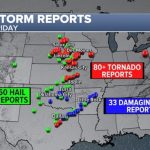© Al Drago/Bloomberg
The Marriner S. Eccles Federal Reserve building in Washington.
Banking sector stress has shot up as a concern for stability in the financial system, according to the latest Federal Reserve survey on major risks to the economy.
As inflation has eased over the past year, troubles at midsize banks emerged as a top concern among market analysts, business leaders, academics and researchers consulted by the Fed, especially in the wake of the failures of Silicon Valley Bank and Signature Bank in March. Those banks collapsed in part because of their overreliance on uninsured deposits, poor risk management and their failure to account for the risks of rising interest rates — hazards that policymakers now see have the ability to trigger broader panic.
“Despite decisive actions by the Federal Reserve, the [Federal Deposit Insurance Corporation], and the U.S. Department of the Treasury, concerns about the economic outlook, credit quality, and funding liquidity could lead banks and other financial institutions to further contract the supply of credit to the economy,” the report read. “A sharp contraction in the availability of credit would drive up the cost of funding for businesses and households, potentially resulting in a slowdown in economic activity.”
The uncertainty tied to rising interest rates in other countries, geopolitical tensions and the possibility of the United States defaulting on its debt were also cited in the Fed’s biannual survey.
The report comes as markets and the broader economy are still rattled from this spring’s banking crisis, when the failures of Silicon Valley Bank and Signature Bank triggered financial panic. Earlier this month, First Republic became the third U.S. bank to be seized by regulators in the past two months. Stocks at a handful of regional banks are still taking a beating. And all over the country, small businesses are feeling banks pull back on lending, hampering their ability to invest and plan for the future.
More regional bank stocks slide, but deposits aren’t fleeing
It’s too soon to tell how much more the economy will suffer. Officials at the Fed expect growth will slow as credit conditions tighten in ways that mimic a rate hike, making it harder for people and businesses to get loans. But they don’t yet know how significant that pullback will be, or if their aggressive rate hike campaign to tame inflation will send other shock waves through the financial system — or even cause a recession.
Also on Monday, a new Fed survey on bank lending practices underscored that lenders expect to tighten loan standards even more in the near future, including for commercial real estate loans.
“Banks most frequently cited an expected deterioration in the credit quality of their loan portfolios and in customers’ collateral values, a reduction in risk tolerance, and concerns about bank funding costs, bank liquidity position, and deposit outflows as reasons for expecting to tighten lending standards over the rest of 2023,” the survey said.
The initial banking crisis is easing. Another may be around the corner.
Last week, shares of PacWest Bancorp plummeted after the company issued a statement overnight saying it was in “ongoing” discussions with partners and investors. Western Alliance also saw its stock price tumble. Shares at both banks recovered in Monday trading, and the firms say their deposit totals are on solid footing. But Wall Street analysts are still wary that other midsize banks — especially those with high proportions of uninsured deposits — are not adequately prepared for a possible downturn, or an extended period when rates stay higher for longer.
Through it all, financial regulators are sticking to the message that the banking system is strong. At a news conference after the Fed raised interest rates again last week, Fed Chair Jerome H. Powell said conditions in the banking sector have “broadly improved” since regulators launched a major rescue campaign to stave off broader contagion, adding that “we’re committed to learning the right lessons from this episode.”
Fed raises rates by 0.25 percentage points in what could be final hike
Late last month, the Fed released a scathing report on the failure of Silicon Valley Bank, and regulators’ own culpability, that now sets the stage to toughen the rules for midsize banks again. The Fed’s top banking cop, Michael Barr, is spearheading that push.
Meanwhile, House Republicans and the White House are still at an impasse over the debt ceiling. The Treasury Department has warned that the United States could default as early as June 1 if the debt limit isn’t raised by then. Powell has consistently said the borrowing cap needs to be raised, and has warned that a default would threaten financial stability.

